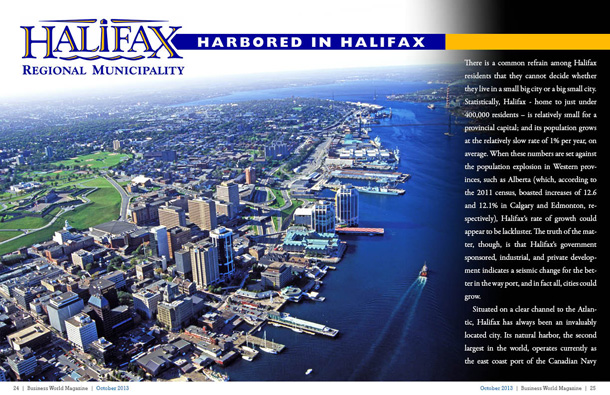
Harbored in Halifax

There is a common refrain among Halifax residents that they cannot decide whether they live in a small big city or a big small city. Statistically, Halifax – home to just under 400,000 residents – is relatively small for a provincial capital; and its population grows at the relatively slow rate of 1% per year, on average. When these numbers are set against the population explosion in Western provinces, such as Alberta (which, according to the 2011 census, boasted increases of 12.6 and 12.1% in Calgary and Edmonton, respectively), Halifax’s rate of growth could appear to be lackluster. The truth of the matter, though, is that Halifax’s government sponsored, industrial, and private development indicates a seismic change for the better in the way port, and in fact all, cities could grow.
Situated on a clear channel to the Atlantic, Halifax has always been an invaluably located city. Its natural harbor, the second largest in the world, operates currently as the east coast port of the Canadian Navy and a docking station for the vibrant cruise ship industry. All told, the port of Halifax generates over 11,000 jobs and $1.5-billion in economic impact each year. Remarkably, while generating revenue and constantly developing the waterfront, Halifax has never over expanded its port, leaving, for example, Pier 21 – the site where over one million émigrés entered Canada for the first time – intact as an important historical monument and museum (which itself garners over $2.5-million per year in revenue). This trend is clear in Halifax’s development: forward thinking matched with mindful preservation.
This is, at least, what Peter Duncan, Manager of Infrastructure for the Halifax Regional Municipality (HRM) believes. While he acknowledges that there are not, necessarily, big-ticket projects and developments coming out of Halifax and creating a countrywide buzz, there are initiatives on the books that he is proud to help from the ground up. One of which is the procurement of funding for long-term development, including a land use plan that is intended to guide the physical growth and development of the HRM for the next 25 years, which plans for 25% growth in urban areas, 50% in the suburbs, and the remaining 25% in what Duncan calls the “exurbs,†residential areas outside the suburbs.
Partnered with this long-term development is a self-sustainability initiative that focuses on retrofitting existing buildings with environmentally sound technology, whether in the form of LED lights or solar heating. Duncan is quick to point out that they’re not merely changing the light bulbs, though. Rather, the more than 280 buildings that are owned by the HRM are individually audited as to what retrofits would best suit the particular building. Once the retrofit has taken place, the building’s energy savings are then monitored, providing a clear, calculable, cost-benefit analysis.
This bipartite system – municipal growth matched equally with environmental sustainability – is an indication of the kind of progressive thinking that characterizes Haligonian development. For example, the Alderney 5 GeoThermal vault is, according to Duncan, the first large-scale application of geothermal seasonal cold-energy storage that doesn’t use a heat pump or refrigeration cycle anywhere in the world. Funded by a joint initiative between the HRM, provincial government, and federal government’s Technology Early Action Measures (TEAM) program, the geothermal vault harvests cold energy from seawater during the winter months. The seawater is then chilled in an underground rock mass, and the stored thermal energy later used (in warmer months) to help meet air conditioning needs. It is projected that the Alderney 5 vault will save $350,000 per year in energy costs and avoid $800,000 in future replacement costs.
Although the Alderney 5 Vault is the first of its kind to use geothermal storage on such a grand scale, multiple offices in downtown Halifax take water from the harbor and use it in their air conditioning systems, says Duncan. In this, and many other ways, Duncan is proud that Halifax has focused so intently on mitigating environmental impact while decreasing utility cost. At the most fundamental level, such initiatives are more prudent in terms of public dollars, ultimately costing less for the taxpayer, which allows the government to direct the savings into other programs that will benefit residents. “Solar Cityâ€, for example, is a new program offered by the HRM whereby they facilitate loans to homeowners who want to convert to solar water heating systems. The loans have either very low or no interest, and are financed over a 10-year period. This simple strategy has caught on in the home building market, meaning that new homes are already being marketed as solar ready.
Another major development is underway at Mount Saint Vincent University where rcs Construction is building the Margaret Norrie McCain Centre. Designed by Harvey Architecture, rcs Construction began work on the Centre in March of 2013, in fact, this is the first new building for MSVU in 42 years. This $16 million dollar infrastructure will include a four-story concrete multipurpose education facility, lecture halls, student breakout study rooms, a two-story atrium, courtyard and Honor Wall; all strategically placed in a central site which connects the upper and lower locations of the campus. When developing, it was determined that a chill beam system would be put into place for heating and cooling, a move that ultimately helps lower operational costs for the Centre, but also contributes to green-friendly practices in the city.
As a city nestled on the coast of the Atlantic, these sustainable initiatives are not merely environmental glad-handing. Sea level rise, says Duncan, is a very real threat to Halifax’s future development. HRM hopes to mitigate the impact of climate change with the aforementioned green initiatives, but has also modeled the impact of sea level rise and used the data to plan future development accordingly. He freely shares this information with the military, scientific community, and public, acknowledging that this data has made its way into land use bylaws, which ensure that private contractors build on safe land.
It is of paramount importance that development in Halifax simultaneously strives forward, yet never disregards its rich historical framework. One of the key issues for the Council is figuring out how to reinvest and reinvigorate the downtown core while maintaining its integrity as one of Canada’s oldest cities.  The team in Halifax feels that this is accomplished by understanding the condition of the assets they currently have (such as is the case with the waterfront), understanding the levels of service the public wants, and investing wisely.
Ships Start Here
The biggest coup in Halifax’s recent history, however, was the landing of a massive shipbuilding contract with the federal government in 2011. The projected $35-billion contract will mostly go to Halifax’s Irving shipbuilders, but the contract will have economic ramifications across the country for the next few decades. The Greater Halifax Partnership projects that in a typical peak year during the contract Nova Scotia’s real GDP will increase by $800-million, as compared to the $569-million increase among other provinces. Furthermore, the Partnership estimates that by 2016, the contract may create as many as 10,000 jobs per year.
The contract is, however, actualizing itself slowly. Defense Minister Peter MacKay inked the first $9.3-million in July 2012, a preliminary contract with Irving designed to facilitate the review of existing ships and plan the execution phase. But it was, as MacKay said, “the starting gun . . . [that] heralds the creation of countless good-paying, long-term jobsâ€. The Halifax motto: “From the Sea, Wealth†has perhaps never proved so prescient. In all eventualities, the capital that can’t decide if it is a small big city or a big small city has, undoubtedly, just become a little larger.
 For more information, please visit their website at:   Halifax








